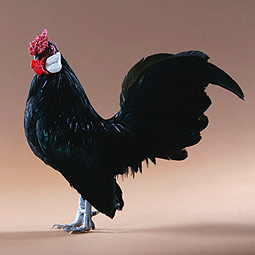
Belgian
There are three main breeds of the Belgian chicken, Belgian d’Anvers,Belgian d’Uccle, and the Belgian de Watermael
Coming from Antwerp, the Belgian Bearded d’Anvers is a bantam but it isn’t derived from a larger bird as is common in most bantam breeds. They are an ornamental bird, kept for breeding for show or for pets and they are very friendly to humans. They do well with free range, not so well with close confinement..
There are fourteen recognized varieties based upon plumage..The most common is porcelain or quail, a small bird with large breasts that project foward and a tail that arches quite a bit.
d’Anvers will have a large beard of feathers covering the earlobes, a small rose comb and small wattles. The hens lay small white eggs and will go broody easily.
Black, White, and Cuckoo varieties will have muggs covering the ear lobes and eyes that will vary from black, brown, even reddish. Very small wattles usually.
The Belgian Bearded d’Uccle is called the ‘Booted Bantam’ and came from Belgium around the turn of the century. They are also called Millefleur or Millies in the U.S. This breed is a very calm bird, small, and creamy or tinted colored feathers. They are very broody and will lay a clutch of eggs in 14 to 21 eggs.
Thee Belgian Bearded de Watermael was custom bred by a couple named Dresse who were trying to create a bantam breed for backyard flock owners. These diminutive birds weigh just over a pound and will produce around 120 forty gram eggs per year
The Belgian Bearded roosters will weigh around 1.75 pounds, hens around 1.5 pounds and lay cream colored eggs. Recognized colors are Black, Golden Neck, Mille Fleur, Mottled, Porcelain, Self Blue, and White.








